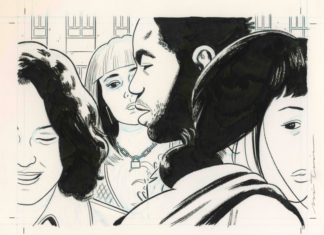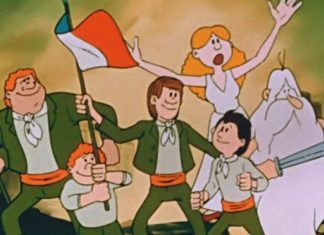Les années 1870-1880 ont donné naissance au Far West et ses mythes. Ce fut le temps des cowboys, des Indiens, des pionniers et des hors-la-loi. Tout cet ensemble est synonyme d’expansion, de défense du territoire et d’appât du gain.
Martha Jane Canary mieux connue sous le nom Calamity Jane est une de ces grandes figures de l’Ouest américain. « L’héroïne des plaines » fut également une image d’opposition face aux standards féminins de l’époque par notamment le fait qu’elle avait pris pour habitude de porter des vêtements d’homme. Mais avant toute chose, qui étais-tu chère Calamity? Quelle est la part du réel et de la légende? Entretien avec Karen R. Jones de l’Université du Kent et autrice du livre « Calamity- The many lives of Calamity Jane » (2020).
.
.
.
Que savons-nous de la jeunesse de Martha?
.
.
.
Seulement des fragments et quelques bribes. Elle est née à Princeton dans le Missouri un 1er mai : Tout le monde s’entend à peu près là-dessus. Son autobiographie, “Vie et aventures de Calamity Jane par elle-même” (1896) publiée pour un dime museum (centre de divertissement) où elle se produisait, indique la date de 1852. Mais pour beaucoup, Martha serait née en 1856 avec pour preuve le recensement de la ville de Ravenna de 1860. Il est en effet figuré qu’elle avait cette année-là l’âge de 4 ans et qu’elle était la fille de Robert et de Charlotte Canary. Au début des années 1860, sa famille est partie vers l’ouest pour faire fortune dans le minerai et s’installa d’abord à Virginia City avant de rejoindre les villes minières du Montana. C’est dans cette région que nous avons une nouvelle trace de Martha : Le “Montana Post” du 31 décembre 1864 écrit un article sur un groupe de jeunes filles frigorifiées et affamées qui aurait cassé la porte du chef de police du comté afin de dérober quelques biens. Suite à la mort de ses deux parents, les temps difficiles ont continué pour Martha. Elle a en effet dû vivre au jour le jour dans un environnement difficile et dangereux.
.
.
.
Cuisinière, danseuse dans un dance hall, prostituée,… La jeune Martha Canary était-elle un exemple parmi d’autres de femmes vivant au Far West?
.
.
.
Elle a certainement enchaîné les petits boulots ce qui était typique des femmes au Far West. Martha s’est retrouvé à  cuisiner, à être blanchisseuse ou (comme certains pensent) à se prostituer. Ces différentes professions étaient très fréquentes en particulier dans les villes minières et dans les campements où s’installaient les hommes de passage. Sans soutien financier ou familial, Martha était livrée à elle-même. Dans un sens, elle était une femme ordinaire au Far West où pour survivre, il fallait être dure et coriace. Martha a également exercé des professions qui n’étaient pas vraiment destinées aux femmes. C’est à cette occasion qu’elle fut connue pour porter des habits d’homme et est ainsi devenue une figure du Far West.
cuisiner, à être blanchisseuse ou (comme certains pensent) à se prostituer. Ces différentes professions étaient très fréquentes en particulier dans les villes minières et dans les campements où s’installaient les hommes de passage. Sans soutien financier ou familial, Martha était livrée à elle-même. Dans un sens, elle était une femme ordinaire au Far West où pour survivre, il fallait être dure et coriace. Martha a également exercé des professions qui n’étaient pas vraiment destinées aux femmes. C’est à cette occasion qu’elle fut connue pour porter des habits d’homme et est ainsi devenue une figure du Far West.
.
.
.
Pensez-vous que Martha a radicalement changé d’aspect et de mentalité lorsqu’elle fut le nom de Calamity Jane?
.
.
.
L’origine du nom reste un mystère ce qui a également contribué à sa renommée dans le folklore de l’Ouest américain. L’histoire la plus répandue est celle qu’elle a racontée : Un capitaine de l’armée américaine lui aurait donné ce sobriquet après que, lors d’une embuscade, Martha lui ait sauvé la vie. D’autres ont raconté qu’elle provoquait la calamité ou qu’elle avait utilisé le terme comme “nom de plume”. Je ne pense pas que Martha ait changé lorsqu’elle est devenue Calamity Jane. Beaucoup de ses biographes ont débattu longuement sur le fait que sa vie et sa légende étaient en totale contradiction. Cependant, j’ai un point de vue différent : Une femme peu orthodoxe comme Martha, qui n’était clairement pas une femme de bonne tenue de l’époque, avait trouvé sa place dans ce Far West qui repoussait toutes les limites de l’acceptable. Cependant, elle a rencontré des difficultés à être dans les codes en particulier avec l’alcool, ses tenues masculines ou encore la pauvreté. Tout cela a rendu son existence plus éprouvante.
.
.
.

.
.
.
Calamity Jane a participé à des expéditions de l’armée mais était-elle perçue comme un soldat par ses compagnons d’armes?
.
.
.
Elle a en effet sûrement accompagné l’armée et a pu ainsi obtenir une certaine réputation dans ses rangs. Des soldats ont narré des histoires sur une étrange femme qui s’habillait avec une peau de daim autour du feu de camp. Le poète militaire Jack Crawford a même écrit des poèmes sur Calamity. Elle a prétendu avoir été rémunérée et nourri par l’armée et qu’elle servait d’“éclaireuse” pour la cavalerie sous le commandement de grands généraux. C’est par contre un mensonge. Calamity fut surtout quelqu’un qui suivait les cortèges de l’armée tout en effectuant des petits travaux domestiques ou même se prostituait avec les soldats.
.
.
.
Pour quelles raisons la ville de Deadwood (Dakota du Sud) a attiré autant de hors-la-loi et d’héros du Far West tels que Wyatt Earp, Wild Bill Hickok ou encore Al Swearengen?
.
.
.
C’était une ville typique du Far West célèbre pour ses minerais qui reposaient partout dans les collines alentours. Et comme beaucoup de colonies minières, Deadwood est devenu célèbre comme lieu de hors-la-loi, de désordres et de fusillades. Les prospecteurs ont afflué pour les mines d’or de Black Hills et par conséquent les hors-la-loi, les chercheurs d’or et autres vagabonds ont suivi le mouvement. Deadwood était également un carrefour de conflits territoriaux entre le gouvernement américain et les indiens Lakota. Par conséquent, ce fut une ville repaire de tensions culturelles et de violence.
hors-la-loi, de désordres et de fusillades. Les prospecteurs ont afflué pour les mines d’or de Black Hills et par conséquent les hors-la-loi, les chercheurs d’or et autres vagabonds ont suivi le mouvement. Deadwood était également un carrefour de conflits territoriaux entre le gouvernement américain et les indiens Lakota. Par conséquent, ce fut une ville repaire de tensions culturelles et de violence.
.
.
.
Que savons-nous des relations entre Martha et Wild Bill?
.
.
.
Leurs rapports sont mêlés de mystère et furent récupérés par les légendes. Les deux se connaissaient certainement depuis quelques mois avant leur arrivée à Deadwood en 1876 avec un  groupe venant de Fort Laramie. Des années plus tard, Calamity Jane a prétendu avoir attrapé l’assassin de Wild Bill, Jack McCall. La partie de poker de Wild Bill a mal tourné et il a été abattu. Calamity prétend avoir pendu McCall à un croc de boucher. Il n’y a pourtant pas la preuve d’un tel acte. Calamity a également affirmé plus tard que elle et Wild Bill s’étaient mis en couple. Là, il n’y a aucune preuve à ce sujet non plus. Calamity et Wild Bill furent enterrés au cimetière de Mount Moriah d’après certains, trop contents d’accueillir les touristes et de raconter des comptines romantiques. Au milieu du XXème siècle, une femme du Montana, Jean McCormick, a écrit un journal intime et prétendit détenir des affaires personnelles de Calamity Jane. Ces dernières auraient alors prouvé l’existence d’une romance entre Wild Bill et Calamity. McCormick affirmait être leur fille. De nombreuses foires et musées locaux se sont alors intéressés à son cas et ont commencé à promouvoir son histoire. Tout ceci s’est finalement révélé faux.
groupe venant de Fort Laramie. Des années plus tard, Calamity Jane a prétendu avoir attrapé l’assassin de Wild Bill, Jack McCall. La partie de poker de Wild Bill a mal tourné et il a été abattu. Calamity prétend avoir pendu McCall à un croc de boucher. Il n’y a pourtant pas la preuve d’un tel acte. Calamity a également affirmé plus tard que elle et Wild Bill s’étaient mis en couple. Là, il n’y a aucune preuve à ce sujet non plus. Calamity et Wild Bill furent enterrés au cimetière de Mount Moriah d’après certains, trop contents d’accueillir les touristes et de raconter des comptines romantiques. Au milieu du XXème siècle, une femme du Montana, Jean McCormick, a écrit un journal intime et prétendit détenir des affaires personnelles de Calamity Jane. Ces dernières auraient alors prouvé l’existence d’une romance entre Wild Bill et Calamity. McCormick affirmait être leur fille. De nombreuses foires et musées locaux se sont alors intéressés à son cas et ont commencé à promouvoir son histoire. Tout ceci s’est finalement révélé faux.
.
.
.
Calamity Jane est resté à Deadwood et aurait aidé les victimes locales d’une épidémie de variole. Pensez-vous que cette supposée solidarité révèle un autre trait de la personnalité de Martha?
.
.
.
Cette histoire fait en effet partie de sa légende mais je ne la vois pas comme une figure enclin à la solidarité. Au contraire, c’était quelqu’un qui était surtout à la marge de la société, qui errait de ville en ville et que la population percevait comme marginale.
.
.
.
Pourquoi Martha a fait des Wild West Shows?
.
.
.
Même si Calamity fut une star de Wild West shows au dime museum de Kohl et de Middleton en tant que pioneer new woman et aussi de l’exposition Pan American, elle ne travailla jamais pour Buffalo Bill Cody. Je pense qu’elle voyait ces shows comme un bon gagne-pain et un moyen d’enrichir sa renommée de légende de l’Ouest. La scène lui permettait de renforcer son univers folklorique et Calamity a même continué à travailler pendant des années en racontant ses histoires durant des feux de camp et dans les saloons.
.
.
.
 .
.
.
.
Pour quelles raisons Calamity Jane est devenue une légende du Far West?
.
.
.
Elle a su incarner le Far West comme univers coloré et comme tournant du XIXème siècle américain. Le Far West est perçu comme un espace de liberté sans contraintes sociales et culturelles. Calamity a également fait perdurer les récits des figures de l’Ouest. Elle a également prouvé que les femmes ont pu assumer à cette époque des responsabilités, se révéler fortes (voire héroïques) et adaptées au milieu hostile de l’Ouest américain. La figure de Calamity Jane reste encore de nos jours une figure forte car elle est à la fois populaire et remarquable. Même si sa vie fut relativement tragique, elle met en lumière une “histoire cachée” de la femme masculine.
.
.
.

.
.
.
Pour en savoir plus :
Le livre de Karen R. Jones (en anglais) : « Calamity- The many lives of Calamity Jane » Yale University Press 2020 https://yalebooks.co.uk/display.asp?k=9780300212808
The 1870s and the 1880s gave birth to the Wild West and laid a foundation to its ensuing mythology. It was an era of posses, Indians, pioneers, outlaws and gunslingers brought together by the purposes of expansion, defense, greed and reinvention.
Martha Jane Canary better known as Calamity Jane is one of the most notorious figures of the Old West. ‘The heroine of the plains’ also went about disrupting feminine standards known for her habit’s wearing men’s attire. But first at all, who were you dear Calamity ? What is real and what is the legend ? Interview with Karen R. Jones (University of Kent), the author of ‘Calamity- The many lives of Calamity Jane’.
What do we know about Martha’s youth ?
We know fragments and scattered pieces about her childhood. She was both in Princeton, Missouri on May 1st:: that much is generally agreed. Her autobiography, Life and Adventures of Calamity Jane, By Herself (1896), which was produced in conjunction with a dime museum show she starred in, claimed a birthdate of 1852. Most, likely, however, she was born in 1856, based on a federal census from Ravenna Township in 1860 which listed her as being four years old and the child of Robert and Charlotte Canary. In the early 1860s, her family moved West in search of mineral wealth and settled first in Virginia City, before moving between other Montana mining towns. Here, we find Martha again in a story from the Montana Post of 31 December 1864, which noted how a group of cold and hungry young girls had knocked on the door of the County Commissioner in search of charitable relief. Hard times continued for Martha in the years that followed, after both her parents died, forcing her to live a hand to mouth existence as a youth in a rough and ready frontier environment.
Cook, dance hall girl, driver, prostitute,… Was young Marta Canary just a common woman in the Old West ?
Certainly, she took on various jobs that were customary of women in the Old West, from cooking and laundry to (some argue) sex work: these domestic services were in high demand, especially in the mining towns and other settlements which were dominated by transient men travelling alone. She was also on her own, without financial or family support, and, in that sense, an ordinary woman on the ‘female frontier’ whose survival depended on being adaptable, resilient and tough. Notably, she also worked jobs that were much more unorthodox for women, and it was here that she got her reputation for wearing men’s clothes, taking on typically male jobs and ‘walking the walk’ of the frontier hero.
laundry to (some argue) sex work: these domestic services were in high demand, especially in the mining towns and other settlements which were dominated by transient men travelling alone. She was also on her own, without financial or family support, and, in that sense, an ordinary woman on the ‘female frontier’ whose survival depended on being adaptable, resilient and tough. Notably, she also worked jobs that were much more unorthodox for women, and it was here that she got her reputation for wearing men’s clothes, taking on typically male jobs and ‘walking the walk’ of the frontier hero.
Do you think Martha definitely had changed (physically, mentally,…) when she was finally named as Calamity Jane ?
The origin of her name somewhat of a mystery, which only adds to her enigma as a figure of western folklore. The most common source for this – a story which she told – was that an army captain named her after she saved him from an ambush. Others talked of how she invited Calamity and many claimed they had coined her famous nom de plume. I don’t think she ‘changed’ when she became Calamity Jane. Many of her biographers have talked in great length about how her life and legend were at odds: however, I see something different at play – an unorthodox woman who did not fit into the usual boundaries of female behaviour and found in the West a perfect ‘stage’ on which to stretch the limits of acceptability. She struggled to live up to her image, for sure, especially as alcohol, gender limitations and poverty made her everyday existence so challenging.
.
.
.

.
.
.
Calamity Jane traveled with army expeditions but was she seen as a soldier to her companions in arms?
She certainly travelled with the army and became a legend in the ranks. Soldiers told stories about the curious woman who dressed in buckskin around the campfire and army poet jack Crawford wrote poems about her. She certainly claimed she was on the payroll and fed the regional chatter about a famous ‘female scout’ that worked with the cavalry under its most notable western generals. That was not true, however. She was, more likely what was known as a ‘camp follower’ – moving with the army train and doing domestic chores or engaged in sex work.
Why did the city of Deadwood (South Dakota) attract so many outlaws and folk heroes (Wyatt Earp, Wild Bill Hickok, Al Swearengen,…) ?
Deadwood was a typical frontier town famed for the mineral fortunes that might be made in the hills nearby, and,  like many mining settlements, it grew rapidly and soon cultivated a reputation as a place of lawlessness, disorder and gunplay. Would-be prospectors flocked here as a jumping off point to the Black Hills goldfields, so it attracted its fair share of outlaws, fortune seekers and drifters. It was also at the centre of disputes over territory between the US government and the Lakota, and thus represented a township very much at the forefront of borderlands culture and colonial violence.
like many mining settlements, it grew rapidly and soon cultivated a reputation as a place of lawlessness, disorder and gunplay. Would-be prospectors flocked here as a jumping off point to the Black Hills goldfields, so it attracted its fair share of outlaws, fortune seekers and drifters. It was also at the centre of disputes over territory between the US government and the Lakota, and thus represented a township very much at the forefront of borderlands culture and colonial violence.
What do we know about Martha and Wild Bill’s relations?
Again, this is a relationship marked by mystery and cloaked in folklore. The two knew each other,  certainly, for a few months in Deadwood in 1876. They travelled into the town with a group from Fort Laramie. Calamity Jane in later years claimed she captured Wild Bill’s killer, Jack McCall, with a meat cleaver, after McCall killed him at the poker table, but there is no evidence this happened. She also, late in life, took to suggesting they were romantic partners, but there isn’t any evidence of that either. The two were buried in adjacent plots in Mount Moriah Cemetery, though, something that local town boosters might be a good tourist move and certainly a placement that fuelled tales of them as lovers. In the mid-20th century a Montana woman named Jean McCormick produced a diary and personal effects supposedly from Calamity Jane, that supposedly provided evidence of a relationship with Wild Bill. McCormick claimed to be their long-lost daughter and grew attention at local fairs and museums for a while with her enticing artefacts of the Old West and famed status. Her story was later exposed as a hoax.
certainly, for a few months in Deadwood in 1876. They travelled into the town with a group from Fort Laramie. Calamity Jane in later years claimed she captured Wild Bill’s killer, Jack McCall, with a meat cleaver, after McCall killed him at the poker table, but there is no evidence this happened. She also, late in life, took to suggesting they were romantic partners, but there isn’t any evidence of that either. The two were buried in adjacent plots in Mount Moriah Cemetery, though, something that local town boosters might be a good tourist move and certainly a placement that fuelled tales of them as lovers. In the mid-20th century a Montana woman named Jean McCormick produced a diary and personal effects supposedly from Calamity Jane, that supposedly provided evidence of a relationship with Wild Bill. McCormick claimed to be their long-lost daughter and grew attention at local fairs and museums for a while with her enticing artefacts of the Old West and famed status. Her story was later exposed as a hoax.
Calamity Jane stayed in Deadwood and helped the victims of a smallpox epidemy. Do you think helping the others was a real aspect of Martha’s personality?
This is a part of her legend, yes, but I don’t see her as a community building helpmate figure, as such. Instead, she strikes as someone who was more on the margins, drifting from town to town and often criticised as an eccentric because she operated outside the usual boundaries of female behaviour.
Why did Martha join Wild West Shows?
She did star in wild West shows– at a dime museum hosted by Kohl and Middleton as a ‘pioneer new woman’ and also at the Pan American Exposition – but never actually worked for Buffalo Bill Cody. Those shows she did perform in, I think she saw as a way to make some money and to trade on her frontier legend. Taking to the stage allowed her to live out her folkloric life and to continue the performance of a frontier celebrity she had worked on for many years when telling stories around the campfire and in the saloon.
.
.
.

.
.
.
For which reasons Calamity Jane became a legendary figure of the Wild West?
She epitomises the ‘Wild West’ as a colourful, grand episode of nineteenth century history, where the frontier offered a space of freedom from social constraints and the usual latitudes of contemporary culture. She also speaks of a place and a time where tall tales were told and people invented themselves as frontier celebrities. She showed the ways in which everyday frontier women took on new responsibilities and challenges and proved to be remarkable resilient, adaptable and heroic. At the same time, she paved an unorthodox path as a woman who did not conform to heteronormative conventions. She remains especially relevant today, I think, because she is both familiar and remarkable, and, especially, because she communicates the personal journey of a woman who – though the reality of her life was quite tragic – highlights a ‘hidden history’ of female masculinity.
.
.
.
 .
.
.
.
Further readings :
‘Calamity- The many lives of Calamity Jane » by Karen R. Jones- Yale University Press 2020







